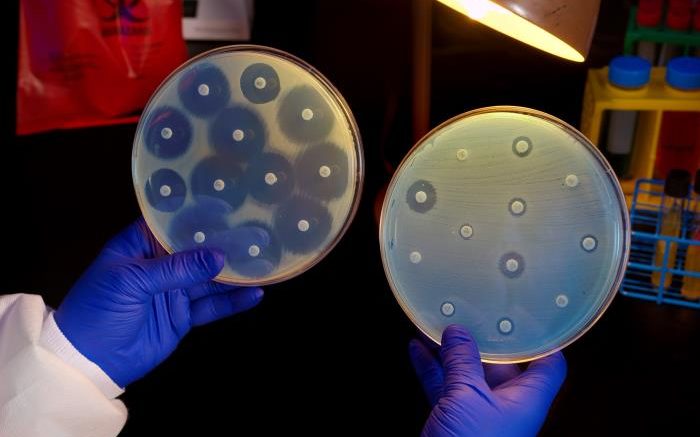This image depicts Centers for Disease Control and Prevention (CDC) microbiologist Kitty Anderson holding up two petri dish culture plates growing bacteria in the presence of discs containing various antibiotics. The isolate, i.e., bacterial species, on the left plate appeared to be susceptible to the antibiotics on the discs, and was therefore, unable to grow adjacent to the discs. The plate on the right, was inoculated with a Carbapenem-resistant Enterobacteriaceae (CRE) bacterium that proved to be resistant to almost all of the antibiotics tested, and was therefore, able to grow nearer the discs. Courtesy of CDC/ Melissa Dankel
Polymyxins (colistin, polymyxin B) have been first-line antibiotics against carbapenem-resistant Enterobacteriaceae (CRE) infections. New anti-CRE antibiotics (ceftazidime-avibactam, meropenem-vaborbactam, plazomicin) improve outcomes in CRE-infected patients and reduce toxicity compared with polymyxins. It is unclear how widely polymyxins and newer agents are used to treat CRE infections. Clancy, et al. (2019) conducted an online survey of U.S. hospital-based pharmacists to determine antibiotic positioning against CRE infections. Numbers of all infections and CRE infections treated with different antibiotics in the United States were determined using IQVIA prescription data and Driving Re-investment in Research and Development and Responsible Antibiotic Use (DRIVE-AB) estimates of CRE infections.
Ceftazidime-avibactam, meropenem-vaborbactam, or plazomicin were positioned as first-line agents against CRE pneumonia, bacteremia, intra-abdominal infections, and urinary tract infections at 87%, 90%, 83%, and 56% of surveyed US hospitals, respectively. From February 2018 to January 2019, an estimated 9437 and 7941 CRE infections were treated with an intravenous polymyxin or new agent, respectively; these figures represented ~28% (range, 19%–50%) and ~23% (range, 16%–42%) of CRE infections in the United States. Use of ceftazidime-avibactam, meropenem-vaborbactam, or plazomicin exceeded that of intravenous polymyxins against CRE infections as of December 2018. Currently, the new drugs are estimated to treat 35% (23% to 62%) of CRE infections in which they were expected to be first-line agents.
The researchers conclude that new anti-CRE agents recently surpassed intravenous polymyxins as treatment for CRE infections, but use is less than expected from their positioning at US hospitals. Research on behavioral and economic factors that impact use of new antibiotics is needed, as are financial “pull” incentives that promote an economically viable marketplace.
Reference: Cornelius J Clancy CJ, et al. Estimating the Treatment of Carbapenem-Resistant Enterobacteriaceae Infections in the United States Using Antibiotic Prescription Data. Open Forum Infectious Diseases. Vol. 6, No. 8, August 2019.

Be the first to comment on "Estimating the Treatment of CRE Infections in the U.S. Using Antibiotic Prescription Data"